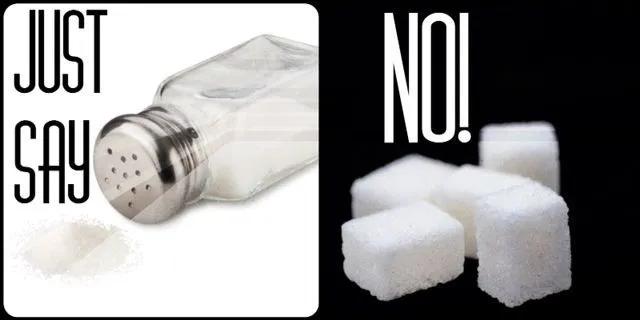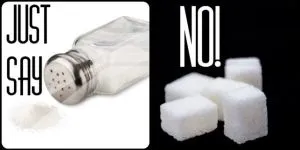
- Share on Facebook232
- Share on Pinterest
- Share on Twitter
We talk a lot about a wide range of food additives and preservatives on a regular basis, to serve as an information source and to warn readers of the health hazards that they present. Many of these additives have long, hard-to-pronounce names and are not extremely well-known.
However, did you know that two of the most dangerous additives found in our food are also the most common? Most processed foods contain them both in abundance, and they can both open the door to chronic illness and take precious years from your life. We’re talking about sugar and refined salt.
The following is a look at how these two substances may be seriously compromising your health, especially if you consume them regularly.
Sugar
Sugar is one of the most dangerous substances consumed today – and it is found in almost every packaged food on the market. Aside from these imposter foods, when we spoon it into our coffee and tea, or add it to baked goods and other goodies, we are directly increasing our risk of a number of debilitating health conditions.
The link between sugar and the escalating rates of overweight and obese individuals in the US is well-established. For just one example of research supporting this, a large-scale study performed in 2011 followed subjects for a period of 20 years, and concluded that those who increased their daily intake of sugary beverages by a single 12-ounce serving gained approximately an extra pound every four years. With each additional sugary beverage, the numbers quickly add up.
Sugar is also known to be a gateway to type 2 diabetes. A 2013 study from the Imperial College in London found that drinking just one (12-ounce) soda per day increases your odds of developing type 2 diabetes by 22 percent. What’s worse is that the researchers found that each additional soda further increases the risk by another 22 percent.
When excess sugar is consumed, the body reacts by releasing insulin into the bloodstream. Over time, this will almost certainly increase your likelihood of developing insulin resistance and type 2 diabetes. Chronically high insulin levels also cause the rapid expansion of the smooth muscle cells that surround your blood vessels. This raises your risk of hypertension, heart disease and stroke.
Sugar, especially high fructose corn syrup – the form of sugar found in many processed foods – is a culprit in nonalcoholic fatty liver disease, which, if left unchecked, can lead to liver failure. When the body receives an overabundance of fructose, the excess is stored as fat in the liver, and is then distributed in various places throughout the body.
This sweet, white poison is even implicated in the development of certain cancers. A 2013 study performed at the University of Edinburgh in Scotland linked a high intake of sugar to an increased susceptibility to colorectal cancer.
On top of that, sugar may lead to premature aging, immune system suppression, depression and other mood imbalances and headaches. It has also been found to be a highly addictive substance, with irritability, headaches and fatigue characterizing sugar withdrawals.
How much sugar are we really eating?
Although the American Heart Association recommends no more than nine teaspoons of sugar per day for men, and no more than six teaspoons for women, on average, Americans consume 22 teaspoons of sugar per day.
But where is it all coming from? One of the primary sources is processed foods. When you look at the ingredient labels of processed and packaged foods, you often see sugar on the list. However, sugar hides under many other names as well, including (but not limited to):
- Barley malt
- Corn syrup solids
- Fruit juice
- Fruit juice concentrate
- Dextran
- Glucose
- Lactose
- Buttered syrup
- Dextrose
- Glucose solids
- Malt syrup
- Cane-juice crystals
- Maltodextrin
Because many processed food labels contain several of the above-listed ingredients, it is not uncommon to see some form of sugar as a first, second AND third ingredient.
Many experts feel that even the recommendations set by the American Heart Association are too high, and that there are no “safe” levels of sugar. A study published in 2013 in the journal Nature Communications fed lab mice a diet that included the equivalent of sugar levels established as “safe” for humans. The researchers found that the mice that consumed this accepted level of sugar experienced toxicity symptoms.
The female mice were found to have doubled their risk of early death, while the male mice exhibited lowered levels of fitness and produced 25 percent fewer offspring than their control group counterparts. The amount of sugar fed to the lab mice in this study equates to humans drinking approximately three sodas per day.
Healthy alternatives
Instead of using sugar for baking or sweetening your morning cup of tea, try using organic coconut crystals, which have a low glycemic index and provide the body with essential nutrients, or crushed, unprocessed stevia leaves, which do not raise blood sugar levels, instead.
You can also use raw honey, which possesses a wealth of health benefits, including antibacterial and antiviral properties, however, remember not to feed it to children under the age of one.
Refined salt
Plain and simple: we could not live without salt. Sodium is essential to the human body, and plays a role in many bodily functions, including cellular metabolism and fluid regulation. It is also instrumental in the functioning of the digestive, nervous and cardiovascular systems. The human body needs about 500 milligrams of sodium per day just to stay alive.
Not getting enough salt in your diet can lead to a condition known as hyponatremia, or sodium deficiency. This can lead to fatigue, confusion, headaches, kidney damage, seizures and coma in serious cases. While salt is vitally important, it’s the type of salt that most of us consume that is the problem: refined salt.
Refined salt is salt that has been chemically processed. The process used to refine it strips away the other trace minerals found in natural salts, leaving only sodium chloride. The additional minerals that natural salts contain are vital to balance out the sodium content, and without them, the salt loses many of its health benefits and becomes quite dangerous.
Aside from stripping away the natural nutrients of real, unprocessed salt, refined salts are often filled with chemical additives, which can include potassium iodide, sodium bicarbonate, solo-co-aluminate, and even fluoride and monosodium glutamate (MSG). Both fluoride and MSG have been linked to debilitating neurotoxic properties.
It is this refinement process that has given salt its bad reputation, and its associations with conditions including hypertension, obesity, type 2 diabetes, water retention and gout. Stripped of the other minerals that natural salts contain, table salt has a dehydrating effect on the body, and pulls water from the blood. This can lead to muscle spasms and digestive disturbances. It can also destroy healthy gut bacteria and lead to toxic buildup in the digestive tract.
A study published in the Journal of Human Hypertension examined the salt-adding habits of children between the ages of 6 and 18. Researchers found that those who added table salt to food before tasting it (thus likely ending up with higher salt intake overall) had higher blood pressure and body mass index (BMI) than children who tasted their food before adding salt, or did not add any at all.
Additionally, refined salt is associated with mood fluctuations, as well as anxiety and depression. A study published in the journal Appetite found a connection between salt and depression, in that women were found to “self-medicate” their depression by adding more salt to their food. While a deficiency in real salt may indeed be a factor in depression, adding more refined salt may well exacerbate the problem.
One of the primary dangers of salt in the American diet is that over 80 percent of the salt we eat comes from processed and fast foods.
Natural, unrefined salt aids in stabilizing blood pressure and blood sugar, helps the body to transport nutrients between cells, and can even boost creativity and long-term planning abilities. It can also aid in weight loss, reduce symptoms of asthma and benefit cardiovascular health. While refined salt is dehydrating, real, unrefined salt can actually re-hydrate you and ease muscle cramps.
Unrefined sea salt is harvested from evaporated seawater, and has none of the chemical additives found in table salt. It also contains trace minerals, including calcium, magnesium, potassium, sulphur, silicon, boron, bromine and strontium. Just be sure that the label specifically says “unrefined,” as there are many refined sea salts on the market.
Another great choice is Himalayan salt. It contains an array of minerals, including silicon, phosphorus and vanadium. With any salt, however, make sure that you are getting enough potassium in your diet, as it is key to balancing out sodium levels.
To live the healthiest life possible, always choose real foods that come from nature, and not a factory. Sugar and refined salt are found in excess in packaged products, and it is these ‘anti-foods’ that are the real culprits.
We like to use AztecSeaSalt, which is not sold in stores. We know for a fact that it is high-quality, unrefined, and loaded with the good minerals and nutrients you need.
-The Alternative Daily
- Share on Facebook232
- Share on Pinterest
- Share on Twitter


